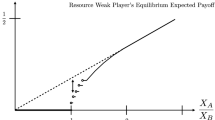Abstract
This paper offers a novel ‘changing places’ account of identification in games, where the consequences of role swapping are crucial. First, it illustrates how such an account is consistent with the view, in classical game theory, that only outcomes (and not pathways) are significant. Second, it argues that this account is superior to the ‘pooled resources’ alternative when it comes to dealing with some situations in which many players identify. Third, it shows how such a ‘changing places’ account can be used in games where some of the players identify with one another, but others do not. Finally, it illustrates how the model can handle the notion that identification comes in degrees.










Similar content being viewed by others
Notes
Fear of reprisal is ruled out in studies where neither player knows the identity of the other, and both know that they will only play the game with one another once.
A game with finitely many players is assumed throughout; the model will break down for infinitely many players, because zero probabilities may nonetheless correspond to possibilities in such circumstances. See, for example, Williamson (2007).
Taking a ‘team perspective’, i.e. considering combined utility, results in a similar ranking. The payoff at the level of the team is 4 if both players cooperate, only 2 if both players defect, and 3 if one player defects and the other cooperates.
I should mention another possible model, where each possible change of place is taken into account, and multiple swaps are allowed. In the three player case, for example, one would consider six possible orderings: 1, 2, 3; 2, 1, 3; 3, 2, 1; 1, 3, 2; 2, 3, 1; and 3, 1, 2. Clearly, such a model is considerably more complex than the one considered here. It is conceivable, however, that it may be superior in some situations.
Identification need not be taken to be reciprocal in the account offered here. We can also imagine a case where three identifies with two but two does not identify with three; then three considers the situation as depicted in Fig. 7, but one and two consider the situation as depicted in Fig. 4 (provided neither identifies with the other).
One need not think that there are precise numerical degrees of identification (just as one need not think that there are precise numerical degrees of belief); in principle, one may work with imprecise probabilities instead.
Modifications to the ‘pooled resources’ approach might also be made in order to allow for degrees of identification; for example, a given player might assign weights to the utilities of the other players. The use of probabilities in the ‘changing places’ account makes the development natural, however, in a way that it has not previously been.
See Rowbottom (in press).
In the latter, but not in the former, the volume of molecules and the forces between molecules are taken into account.
References
Bacharach, M. (2001). Superagency: Beyond an individualistic theory of games. In J. van Benthem (Ed.), Proceedings of the 8th conference on theoretical aspects of rationality and knowledge (pp. 333–337). San Francisco: Morgan Kaufmann.
Bacharach, M. (2006). Beyond individual choice: Teams and frames in game theory. N. Gold and R. Sugden, eds. Princeton: Princeton University Press.
Gillies, D. (2000). Philosophical theories of probability. London: Routledge.
Goldman, A. I. (2006). Simulating minds. Oxford: Oxford University Press.
Harsanyi, J. C. (1953). Cardinal utility in welfare economics and in the theory of risk-taking. The Journal of Political Economy, 61, 434–435.
Harsanyi, J. C. (1955). Cardinal welfare, individualistic ethics, and interpersonal comparisons of utility. The Journal of Political Economy, 63, 309–321.
Harsanyi, J. C. (1975). Can the maximin principle serve as a basis for morality? A critique of John Rawls’s theory. The American Political Science Review, 69, 594–606.
Iacoboni, M., Woods, R. P., Brass, M., Bekkering, H., Mazziotta, J. C., & Rizzolatti, G. (1999). Cortical mechanisms of human imitation. Science, 286, 2526–2528.
Jaynes, E. T. (2003). Probability theory: The logic of science. Cambridge: Cambridge University Press.
Keynes, J. M. (1921). A treatise on probability. London: Macmillan.
Kuhn, T. S. (1977). Objectivity, value judgment and theory choice. In The essential tension: Selected studies in scientific tradition and change. Chicago: University of Chicago Press.
Rawls, J. (1971). A theory of justice. Cambridge: Belknap.
Rowbottom, D. P. (2008). On the proximity of the logical and “objective Bayesian” interpretations of probability. Erkenntnis, 69(3), 335–349.
Rowbottom, D. P. (2011). Popper’s critical rationalism: A philosophical investigation. London: Routledge.
Rowbottom, D. P. (in press). The instrumentalist’s new clothes. Philosophy of Science.
Sally, D. (1995). Conversation and cooperation in social dilemmas: A meta-analysis of experiments from 1958 to 1992. Rationality and Society, 7, 58–92.
Seidenfeld, T. (1986). Entropy and uncertainty. Philosophy of Science, 53, 467–491.
Sugden, R. (1993). Thinking as a team: Towards an explanation of nonselfish behavior. Social Philosophy and Policy, 10, 69–89.
Sugden, R. (2000). Team preferences. Economics and Philosophy, 16, 175–204.
Vickrey, W. (1945). Measuring marginal utility by reactions to risk. Econometrica, 13, 319–333.
Williamson, J. (2010). In defence of objective Bayesianism. Oxford: Oxford University Press.
Williamson, T. (2007). How probable is an infinite sequence of heads? Analysis, 67, 173–180.
Acknowledgments
I am grateful to three anonymous referees for their comments on a previous version of this paper, which helped my thinking on these matters considerably. I should also like to thank the British Academy and the Sydney Centre for the Foundations of Science for supporting this research.
Author information
Authors and Affiliations
Corresponding author
Rights and permissions
About this article
Cite this article
Rowbottom, D.P. Identification in Games: Changing Places. Erkenn 77, 197–206 (2012). https://doi.org/10.1007/s10670-011-9357-0
Received:
Accepted:
Published:
Issue Date:
DOI: https://doi.org/10.1007/s10670-011-9357-0




